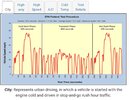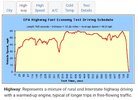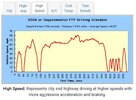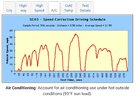My thought is waste heat is such a large percentage of the overall energy used on ICE that the effect of a small change in load does not have a large effect on consumption. Where as with an EV a small change in load translates directly into a large change in consumption as there is very little waste.
That's sound logic, but it's not how the math works. A 90% efficient EV can meet a 270 Wh/mile road load with 300 Wh/mile of battery energy whereas a 20% efficient ICE needs 1350 Wh/mile of heat energy. All else equal, increasing the road load 10% to 297 Wh/mile increases both the EV battery energy and ICE energy requirement by 10%. And range for both will decrease by 10%.
There are exceptions. Winter, for example. As Mongo mentions, the ICE gets "free" cabin heat in winter. And the battery actually loses capacity when cold, while gasoline does not. Of course a cold engine block might burn that gasoline less efficiently, but the block heats up quickly and again mostly using "free" waste heat. The more massive battery, on the other hand, might require active heating. You can also lose regen when starting out cold. These small hits add up.
It's also possible Tesla super-tuned their aerodynamics for straight-ahead airflow and, as a result, their Cd degrades more rapidly in cross-winds. I kinda doubt this, but it would increase the gap between EPA and real world.
There's one other EV vs. ICE issue. I used 20% in the above example, but ICE efficiency varies a lot more with road load than EV efficiency. Most conventional ICE today are ridiculously overpowered for highway cruising. If my 10% increase in road load comes from driving 5% faster, that's a 15% increase in power. That might move the ICE to a better spot on the BSFC map, maybe 20.5% efficient instead of 20%. In this case my 10% increase in road load
does not increase fuel consumption by 10%, but by only 7.3%. (All made up numbers, but you get the idea).
My final point (I promise

is that range is much more psychologically important in a BEV. Gas stations are everywhere are fill-ups are fast. So even if both ICE and BEV suffer a 20% range hit due to higher speed or whatever, it will "feel" a lot worse in the BEV.






